The Sarina family carried on a tradition of hand puppet theater going back to Peppino Sarina’s grandfather, Andrea Sarina, born in Lodi (Lombardy, Italy) in 1828. Andrea began his activity as a puppeteer after a lengthy imprisonment in Austria resulting from his participation, as a protagonist, in the Five Days of Milan, an anti-Austrian rebellion in 1848 that proved to be an important event of the Italian Risorgimento. To survive upon his release from prison, Andrea improvised small street performances with a single puppet. He subsequently developed his technique and created a repertory consisting largely of medieval epic narratives, in particular, the Carolingian cycle. His son Antonio, born in 1857, further developed the family business: he began to sculpt puppets and paint the scenery. The family company established itself professionally, perfected the techniques of representation, and introduced music at the beginning of the performances. All members of the family, in fact, were musicians: Antonio played the flute and his wife Adele the banjo; their elder son Peppino played the accordion, their daughter Teresa the guitar, and their younger son Andreino the violin. Sadly, Andreino, an extroverted personality, inventor of characters, and excellent painter and musician, died as a soldier in the First World War.
Giuseppe Contardo Mario (Peppino) was born to Antonio Sarina and Adele Palamede in Broni (Lombardy) in 1884. From an early age, Peppino’s talent, theatrical genius, and organizational vocation placed him at the head of the family company. Self-taught in many fields of knowledge and artistic disciplines (from music to history to literature to painting), Peppino began to sculpt puppets, paint scenarios and posters (cartelli), write scripts, and compose musical works. Peppino’s best-known work, performed and adapted continuously throughout his life, was the Carolingian cycle of the Paladini di Francia (Paladins of France) and the Reali di Francia (Royals of France) which, divided into consecutive episodes comprising up to one hundred and fifty evenings, occupied an entire season in the same location. The many performances staged in daily installments constitute a paradigm of Peppino Sarina’s dramatic production method, which brilliantly adapted the innumerable sources drawn from avid reading and study, adding to them multiple and original invented elements.
The repertory of the Sarina family was extremely vast. Already Andrea and, above all, Antonio adapted the best selection of dramas being performed by contemporary puppeteers during the late nineteenth and early twentieth centuries, including works such as Il fornaretto di Venezia [The Baker of Venice], La caverna della morte [The Cavern of Death], I due sergenti [The Two Sargeants], Gli esiliati in Siberia [The Exiles in Siberia], Il conte di Montecristo [The Count of Montecristo], and Margherita Pusterla, as well as stories about saints, transpositions of melodramas, and historical dramas. Peppino subsequently contributed by elaborating and significantly expanding this already rich repertory. At the same time, however, in the years of his most intense activity, Peppino restricted and strengthened his repertory, abandoning many works staged by his father Antonio, probably to give more space to cyclical representations with a chivalric theme. In fact, Peppino’s repertory featured complex cyclical productions derived from epic narratives (such as Reali di Francia and Paladini di Francia, mentioned above, Crociati in Palestina [Crusaders in Palestine], and Guerrin Meschino). In addition, Peppino composed and staged dramatizations of literary and historical-legendary works (L’uomo che ride [The Man Who Laughs], Federico Barbarossa, Umberto Biancamano, Mayno della Spinetta, and other stories of brigands), hagiographies, and a very large production of comedies and farces that included the principal masks of northern Italy (in addition to Tascone, Pampalughino, Fastidio, la Vecchia Simona, Mariollo, exclusive to the Sarina family, there were more widely-known figures such as Brighella, Gioppino, Meneghino, Tartaglia, Balanzone, Pantalone, and Arlecchino).
From “Peppino Sarina” by Pietro Porta, The Literary Encyclopedia, full entry available here. For a comprehensive study on the Sarina family, with particular attention to Peppino Sarina, see Pietro Porta, La gente di Sarina Il burattinaio Peppino Sarina e le comunità del Tortonese e dell’Oltrepò pavese nella prima metà del Novecento (Vigevano [PV]: Diakronia, 1997).
The illustration of “Orlando e la fata Morgana” at the top of the page corresponds to an episode from Matteo Maria Boiardo’s Orlando Innamorato. The photo, from the Sarina family archives, is courtesy of Pietro Porta.
A concise overview of the Sarina family repertory (in Italian) by Pietro Porta is available here.
The 12 notebooks constituting the Paladini di Francia cycle will be uploaded to this page in the near future.
Elenco copioni manoscritti del Fondo Sarina, riduzione da inventario, presso Fondazione Cassa di Risparmio di Tortona (AL, Italy). List of extant Sarina family scripts in manuscript form.
A list of printed scripts present in the Sarina family library is available here.
Inventario Fondo Sarina, copioni – libretti d’opera, September 30, 2009. An inventory of the Sarina family’s scripts and libretti (3 pdfs of 43, 53, and 60 pages). Fondazione Cassa di Risparmio di Tortona (AL, Italy).
Fondo Sarina -copioni – libretti opera-1 di 3
Fondo Sarina copioni – libretti opera 2 di 3
Fondo Sarina copioni – libretti opera 3 di 3
